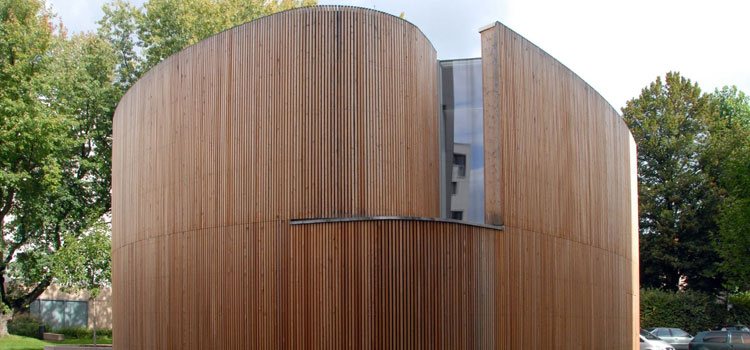
Although the building on Goethe University’s Westend Campus was inaugurated in 2010, due to the Corona pandemic, its tenth anniversary had to be cancelled. Making up for that, a “10+2” celebration was held on November 10, 2022. The „House of Silence“ is no mosque or church and it is not only aimed at believers. Instead, it serves as a place for all those seeking a moment of peace and contemplation in university life. In their welcoming speeches, both Ayse Asar, state secretary in the Hessian Ministry of Science and the Arts and one of the House’s founding members – it was inaugurated during her time at Goethe University – and Goethe University President Prof. Enrico Schleiff paid tribute to the House of Silence as a unique place of diversity and tolerance within the university setting.
„When the House of Silence first opened its doors on October 5, 2010, it did so out of a deliberate choice to set up a space on the Westend Campus that is equally open to members of all religions,” Schleiff emphasized, adding that, “Anyone looking for denominational symbolism will be searching in vain. The aim of the House of Silence is to practice openness, tolerance and pluralism under one roof. True to its name, this openness is not limited to the practice of religion alone, but also applies to meditation, for example. As a university place of deceleration and contemplation, it is aimed at the entire university public: After all, the pandemic-related increase in the use of video conferencing, digital teaching or e-mail – which has meanwhile become a real-time medium – contribute significantly to an acceleration of our society and our everyday life, making places of deceleration more valuable than ever. In this respect, the conceptual expansion of functions ensured that the House of Silence remains relevant also in times like these.“
„It is impossible to imagine Goethe University’s Westend Campus without the ‚House of Silence,'“ said Ayse Asar. „When it was built 12 years ago, the main priority was to create adequate spaces for prayer. But to me, the ‚House of Silence‘ is so much more: It offers the university, whose students come from 130 different countries of origin (spanning all five continents), the chance to develop new forward-looking ways for communal work and life. In so doing, it makes an extraordinary contribution to the university’s representation of academic living and learning culture, on the one hand, and to opening up the possibility of intercultural dialog, personality development and an independent structuring of communal life, on the other. After all, we need bright and creative minds to tackle the challenges of the present and the future with empathy and inquisitiveness. That is why it is all the more gratifying to see that this very concept has been working for 12 years already. I offer up my warmest congratulations on this anniversary and would like to wish all university members continued inspiring encounters in the ‚House of Silence‘.“
The idea for an interreligious place first came up during Goethe University’s move to the Westend Campus. The „House of Silence“ was designed by Munich-based architectural firm Karl und Probst: It features high walls, an interesting lighting design and a work of art in gold. Instead of the university running the house, it is operated by an „Association for the Promotion of Interreligious Dialog at Goethe University Frankfurt am Main“, which was specifically founded for this purpose. Both the association and its board are made up of representatives of all religions.
The anniversary was marked with an event in Goethe University’s ceremonial hall. In his speech, Prof. Rudolf Steinberg, Chairman of the Association’s Board of Trustees and one of the institution’s co-founders, referred to the House of Silence’s genesis and development, emphasizing that, „As a constitutional lawyer, I am convinced that this form of religiosity has its place in a secular university.“ The keynote address on the topic of „Spaces of Silence and the Struggle for the Religion-Sensitive University“ was given by religious studies scholar Prof. Alexander-Kenneth Nagel of the University of Göttingen. For the concluding panel discussion on „The Truth of Others“, moderated by Prof. Joachim Valentin, Chairman of the Council of Religions Frankfurt (Rat der Religionen Frankfurt), Nagel was joined by Prof. Anja Middelbeck-Varwick, Prof. Christian Wiese and Prof. Armina Omerika (all Goethe University). The closing remarks were delivered by Rania Boujana, chairwoman of the Islamic university community. Ahead of the festivities, students of the religious study foundations had held a prayer in the House of Silence.
More on the topic:
UniReport interview with Prof. Rudolf Steinberg on the “House of Silence”








